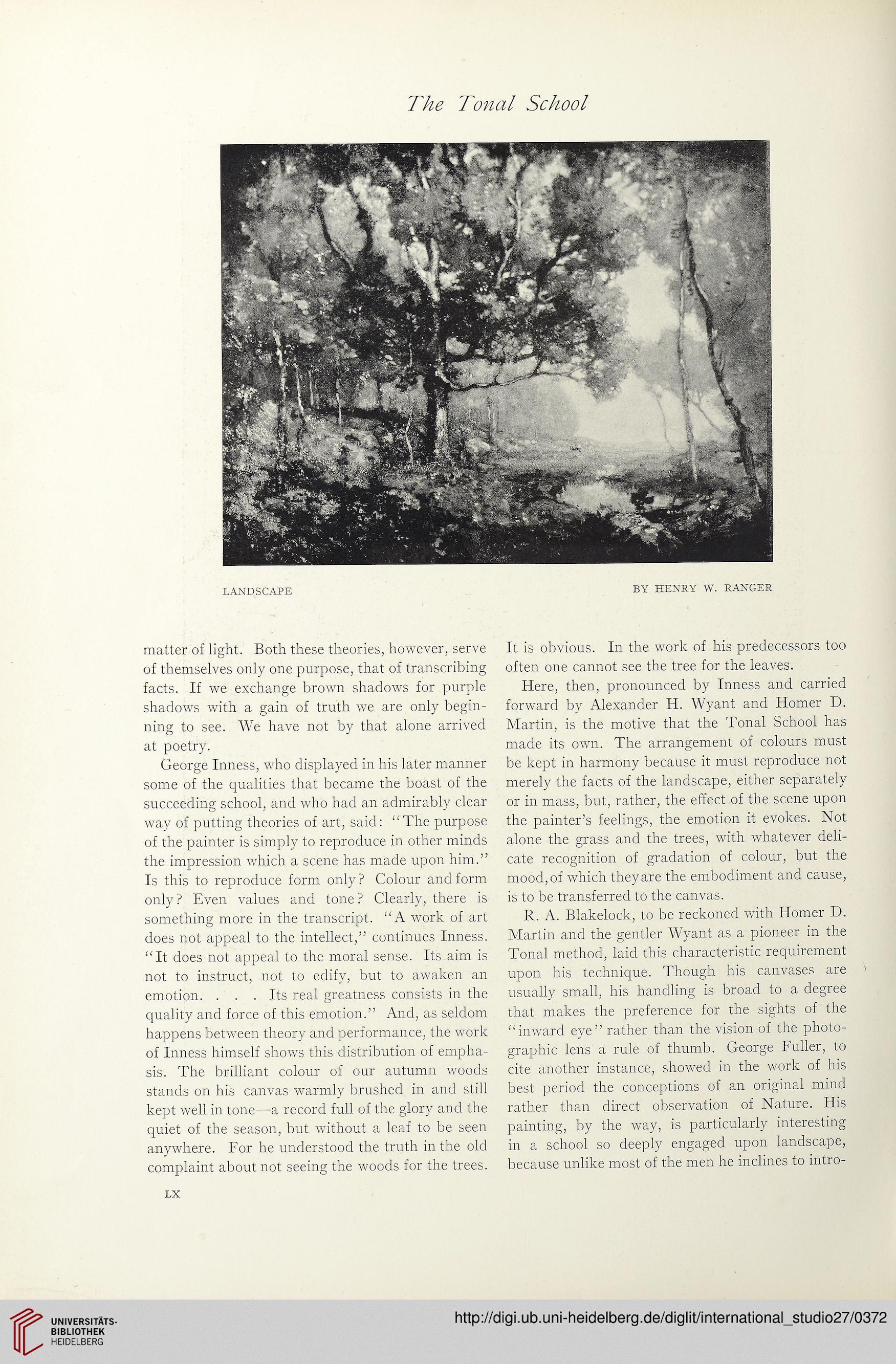The Tonal School
LANDSCAPE
BY HENRY W. RANGER
matter of light. Both these theories, however, serve
of themselves only one purpose, that of transcribing
facts. If we exchange brown shadows for purple
shadows with a gain of truth we are only begin-
ning to see. We have not by that alone arrived
at poetry.
George Inness, who displayed in his later manner
some of the qualities that became the boast of the
succeeding school, and who had an admirably clear
way of putting theories of art, said: “The purpose
of the painter is simply to reproduce in other minds
the impression which a scene has made upon him.”
Is this to reproduce form only ? Colour and form
only? Even values and tone? Clearly, there is
something more in the transcript. “A work of art
does not appeal to the intellect,” continues Inness.
“It does not appeal to the moral sense. Its.aim is
not to instruct, not to edify, but to awaken an
emotion. . . . Its real greatness consists in the
quality and force of this emotion.” And, as seldom
happens between theory and performance, the work
of Inness himself shows this distribution of ernpha-
sis. The brilliant colour of our autumn woocls
Stands on his canvas warmly brushed in and still
kept well in tone—a record full of the glory and the
quiet of the season, but without a leaf to be seen
anywhere. For he understood the truth in the old
complaint about not seeing the woods for the trees.
LX
It is obvious. In the work of his predecessors too
offen one cannot see the tree for the leaves.
Here, then, pronounced by Inness and carried
forward by Alexander H. Wyant and Homer D.
Martin, is the motive that the Tonal School has
made its own. The arrangement of colours must
be kept in harmony because it must reproduce not
merely the facts of the landscape, either separately
or in mass, but, rather, the effect of the scene upon
the painter’s feelings, the emotion it evokes. Not
alone the grass and the trees, with whatever deli-
cate recognition of gradation of colour, but the
mood,of which theyare the embodiment and cause,
is to be transferred to the canvas.
R. A. Blakelock, to be reckoned with Homer D.
Martin and the gentler Wyant as a pioneer in the
Tonal method, laid this characteristic requirement
upon his technique. Though his canvases are
usually small, his handling is broad to a degree
that makes the preference for the sights of the
“inward eye” rather than the vision of the photo-
graphic lens a rule of thumb. George Füller, to
eite another instance, showed in the work of his
best period the conceptions of an original mind
rather than direct observation of Nature. His
painting, by the way, is particularly interesting
in a school so deeply engaged upon landscape,
because unlike most of the men he inclines to intro-
LANDSCAPE
BY HENRY W. RANGER
matter of light. Both these theories, however, serve
of themselves only one purpose, that of transcribing
facts. If we exchange brown shadows for purple
shadows with a gain of truth we are only begin-
ning to see. We have not by that alone arrived
at poetry.
George Inness, who displayed in his later manner
some of the qualities that became the boast of the
succeeding school, and who had an admirably clear
way of putting theories of art, said: “The purpose
of the painter is simply to reproduce in other minds
the impression which a scene has made upon him.”
Is this to reproduce form only ? Colour and form
only? Even values and tone? Clearly, there is
something more in the transcript. “A work of art
does not appeal to the intellect,” continues Inness.
“It does not appeal to the moral sense. Its.aim is
not to instruct, not to edify, but to awaken an
emotion. . . . Its real greatness consists in the
quality and force of this emotion.” And, as seldom
happens between theory and performance, the work
of Inness himself shows this distribution of ernpha-
sis. The brilliant colour of our autumn woocls
Stands on his canvas warmly brushed in and still
kept well in tone—a record full of the glory and the
quiet of the season, but without a leaf to be seen
anywhere. For he understood the truth in the old
complaint about not seeing the woods for the trees.
LX
It is obvious. In the work of his predecessors too
offen one cannot see the tree for the leaves.
Here, then, pronounced by Inness and carried
forward by Alexander H. Wyant and Homer D.
Martin, is the motive that the Tonal School has
made its own. The arrangement of colours must
be kept in harmony because it must reproduce not
merely the facts of the landscape, either separately
or in mass, but, rather, the effect of the scene upon
the painter’s feelings, the emotion it evokes. Not
alone the grass and the trees, with whatever deli-
cate recognition of gradation of colour, but the
mood,of which theyare the embodiment and cause,
is to be transferred to the canvas.
R. A. Blakelock, to be reckoned with Homer D.
Martin and the gentler Wyant as a pioneer in the
Tonal method, laid this characteristic requirement
upon his technique. Though his canvases are
usually small, his handling is broad to a degree
that makes the preference for the sights of the
“inward eye” rather than the vision of the photo-
graphic lens a rule of thumb. George Füller, to
eite another instance, showed in the work of his
best period the conceptions of an original mind
rather than direct observation of Nature. His
painting, by the way, is particularly interesting
in a school so deeply engaged upon landscape,
because unlike most of the men he inclines to intro-




